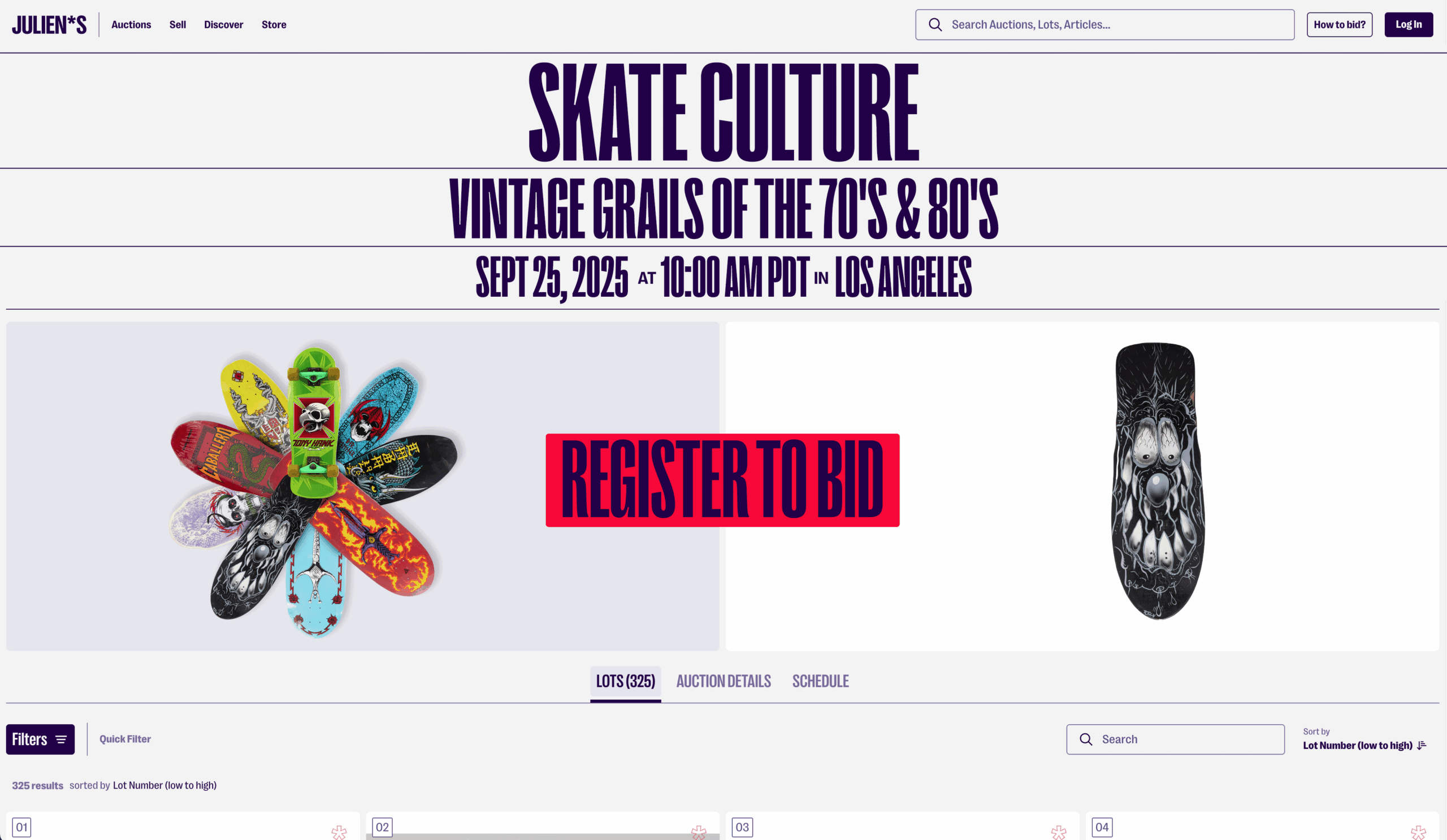
Written By
Regina Luz Jordan
Founder & Editor In Chief
Skateboarding was never polished. It started in empty pools and on rough sidewalks, built by kids who didn’t fit anywhere else. It was raw and loud and alive. Now Julien’s Auctions is putting 338 lots of vintage decks, shirts, and skate relics up for bid. What once lived underground is on the block in Los Angeles is now part of an incredible skateboarding auction. The jump from subculture to auction house gold says everything about how skateboarding grew from rebellion into history.
Dogtown and the Bones Brigade in a Skateboarding AUction
Dogtown skaters were rule breakers.
They rode drained swimming pools when no one else thought to try it. They made skateboarding fast and dangerous.

Mitchell Kaba, Lead Specialist at Julien’s, put it this way:
“Dogtown matters because the Z-Boys, who were from the Dogtown district of Venice Beach, were one of the first teams to bring a rebellious attitude to the sport. They broke the rules, and were fearless and unapologetically raw; and they were the ones who really laid the foundation for the whole vert ramp explosion after they started riding empty swimming pools.”

From that crew came Powell-Peralta and the Bones Brigade. That team turned skating into a movement, with bold graphics and videos that carried the culture worldwide.
Artists like Craig Stecyk and Vernon Courtlandt Johnson gave skateboarding its look, making each board a piece of art as much as a piece of gear.
But let’s not get it twisted. Because subcultures and diversity are topics that we love to write about and we’re deeply passionate about them. Skate culture was way underground. It wasn’t glossy sports coverage or big brand sponsorships. It was VHS tapes passed hand to hand. It was kids tagging their school notebooks with Bones Brigade logos.
It was grainy films like The Search for Animal Chin featuring a young Tony Hawk and later Mid90s, Jonah Hill’s passion project about growing up in Los Angeles.
These movies captured how skating lived in the shadows, halfway between the rise of hip hop and punk rock, eventually grunge and old school. Skating didn’t belong to the mainstream, it belonged to the outsiders who built it.

Representation on Wheels

Unlike other sports in the 70s and 80s, skateboarding didn’t care who you were or where you came from. If you had a board and the guts to ride it, you had a place. That is what made skate culture so different. It wasn’t polished or exclusive.
It was a space where diversity was celebrated. Some of the names that made that clear:
- Tommy Guerrero — A kid from San Francisco’s Mission District who turned his Chicano roots and street style into skateboarding history. Guerrero showed that skating could come straight out of the city and belong to everyone.
- Ray Barbee — One of the first Black skaters to break into the spotlight. His smooth street style and creativity expanded what skateboarding could look like and who it could represent.
- Steve Steadham — A Black skater who pushed into the vert scene and brought visibility where it had been missing. His Skull and Spade deck is still one of Powell-Peralta’s most iconic designs.
- Shogo Kubo — A Japanese-born Dogtown rider who helped define pool skating and the Venice Beach style. His presence proved that skating wasn’t only for kids from the suburbs.
- Peggy Oki — The only female Z-Boy, Japanese American and a trailblazer who held her own in a male-dominated sport.
These skaters weren’t exceptions. They were the culture. Skateboarding thrived because it welcomed the misfits and gave them power. While other sports were building walls, skating was tearing them down and it didn’t need to be the Olympic-X Games-Warped Tour icon it would become in order fro it to matter.
The Skateboarding Auction includes Zorlac and the Outlaw Edge
If Powell-Peralta made skating look like art, Zorlac made it feel like danger. Based in Texas, Zorlac was all grit and attitude. Their decks carried the work of artist Pushead, the same guy who created graphics for Metallica and the Misfits.
That crossover between music and skateboarding mattered. It linked skating to punk and metal in a way that made sense. Both were loud, both were angry and both gave kids an outlet when nothing else did in an era where latchkey kids were the norm.

Zorlac sold more than just skateboards. Zorlac sold an identity. Their look was menacing, raw, and unapologetic. Where Powell-Peralta’s graphics felt polished, Zorlac’s art was darker and more underground. That edge made them legendary, and it kept skateboarding tied to its outlaw roots even as the culture started getting bigger.
From Subculture to Auction Block
The Julien’s sale makes one thing clear. Skateboarding is a cultural force and not just some random sidenote. The auction features hundreds of boards and decks from the most iconic brands in skate history: Powell-Peralta, Dogtown, Santa Cruz, Vision, Sims and Zorlac, alongside a treasure trove of vintage T-shirts, signed memorabilia and ephemera that defined a generation.

Headlining the collection is an original hand-painted skateboard by Ed “Big Daddy” Roth (estimate $1,000–$2,000). Roth was a titan of Southern California’s Kustom Kulture, best known for his grotesque Rat Fink character.

His style shaped underground comix and punk rock art, both of which flowed straight into skateboarding’s DNA. This board, signed and painted by Roth himself, is where hot-rod art and skateboarding meet. It’s a rare convergence that shows just how wide skate culture’s impact really is.
Alongside Roth’s piece, the top skate draws prove how far this “tiny subculture” has come:
- Tony Hawk’s “Chicken Skull” Deck — Estimates up to $1,200 show how the kid who once rode backyard ramps became a global name.
- Steve Caballero’s “Dragon” Decks — Multiple dragon graphics, each valued at $800–$1,200, prove how iconic his art and influence remain.
- Rodney Mullen’s “Mutt” and “Chess” Decks — Estimated at $600–$800, these highlight the father of street skating and his long-overdue recognition.
- Ray Barbee’s “Ragdoll” Deck — With estimates at $600–$800, Barbee’s role as one of the first Black skaters in the spotlight is being recognized in real time.
- Tommy Guerrero’s “Flaming Dagger” Deck — Estimated up to $1,200, proof that a Mission District kid’s style carried Latino culture into the history of skateboarding.
This auction validates the people and the culture behind them. Contributions that once seemed invisible are now commanding space at one of the world’s leading auction houses. That shift shows that skateboarding’s rebellion mattered then, and it still matters now.
How to Bid in Julien’s Skateboarding Auction
“Skate Culture: Vintage Grails of the 70’s & 80’s — No Reserve Auction” takes place Tuesday, September 24, 2025 at 10:00 AM PDT in Los Angeles.
The sale is hosted by Julien’s Auctions, known worldwide as the “auction house to the stars.” Bidding is open online and by phone, with registration available through juliensauctions.com.
For collectors, this is a chance to grab pieces of history. For everyone else, it’s proof that a subculture once written off as rebellion, now stands recognized as one of America’s most impactful cultural movements.



Leave a Reply